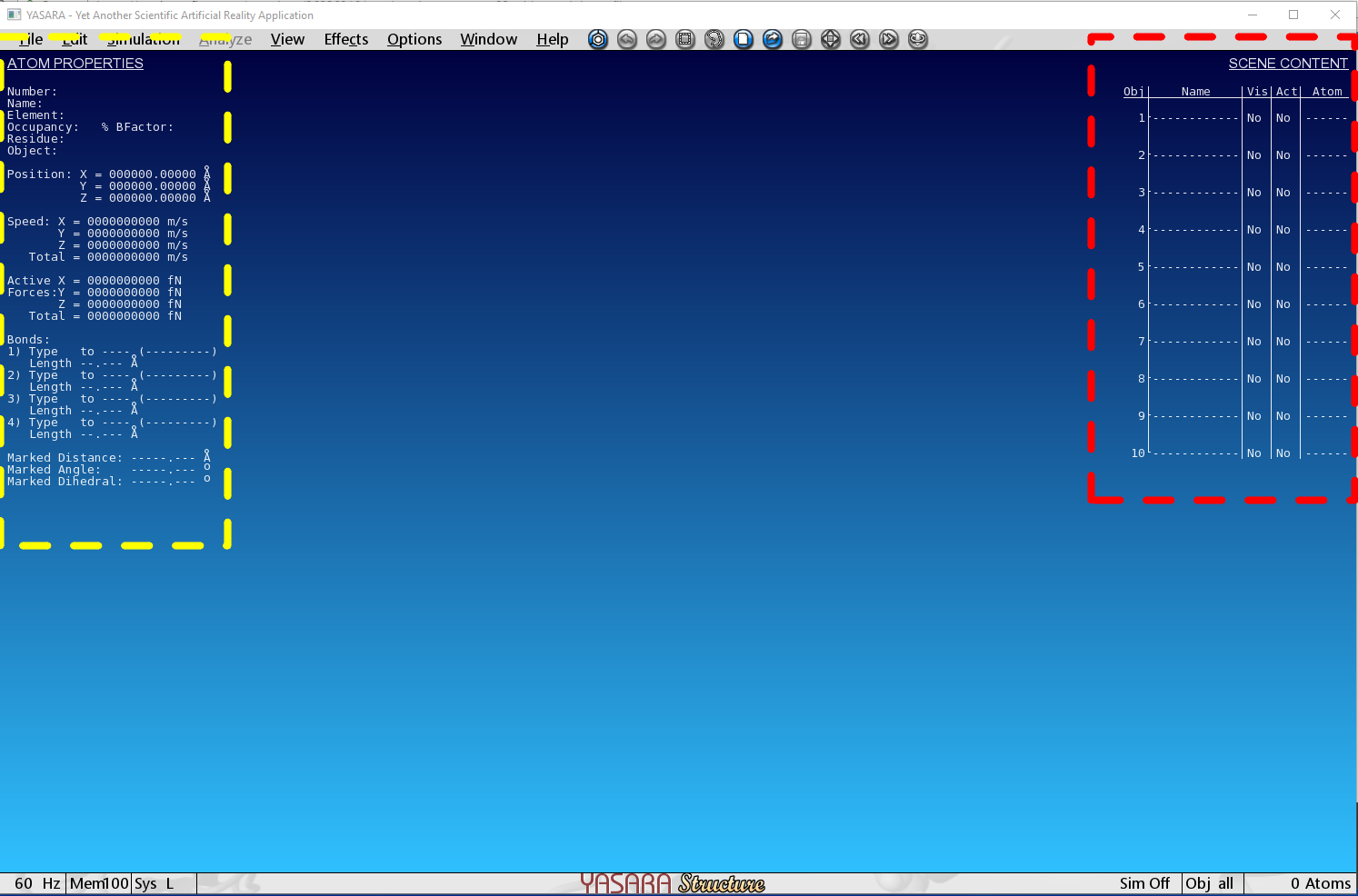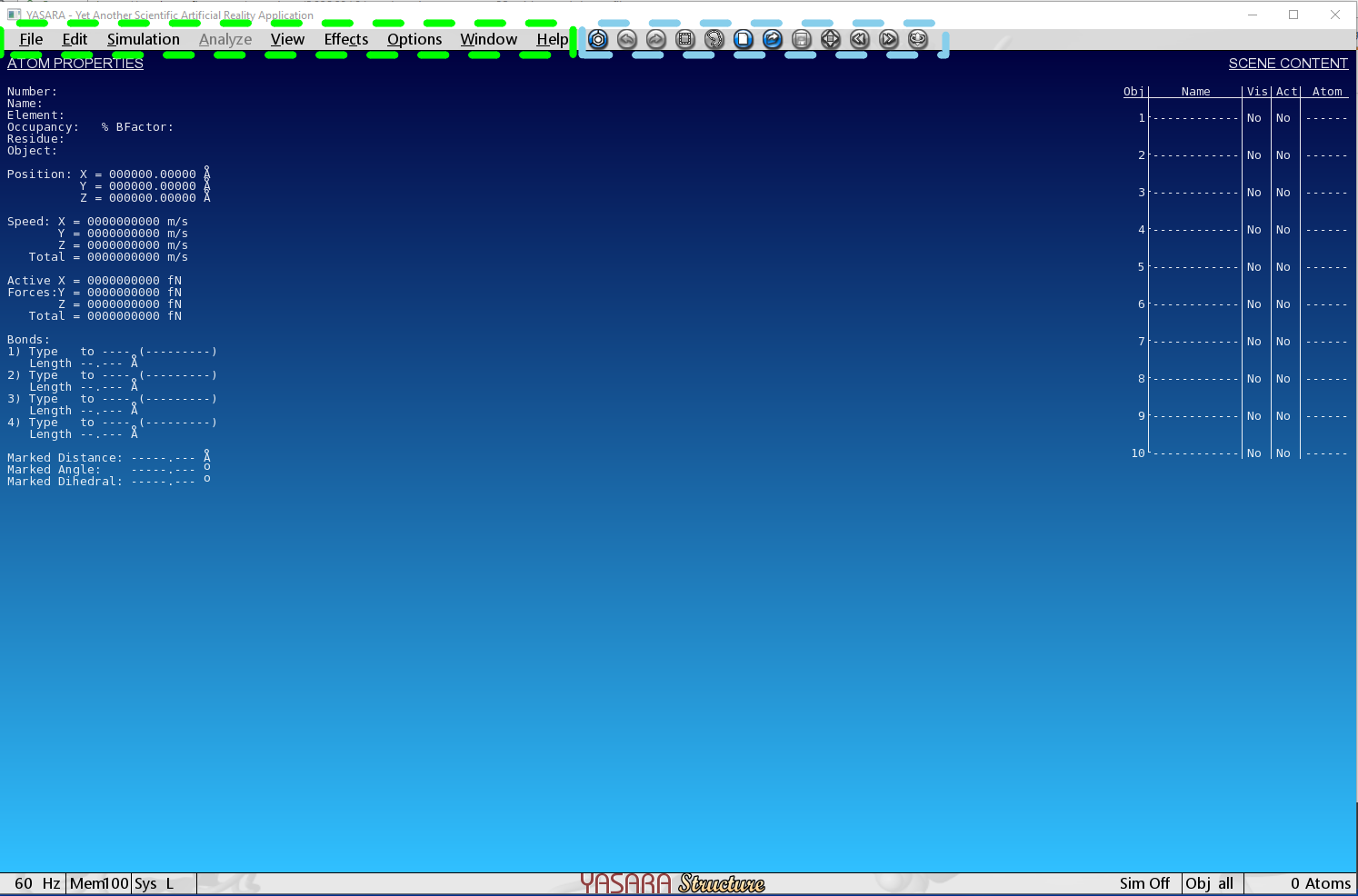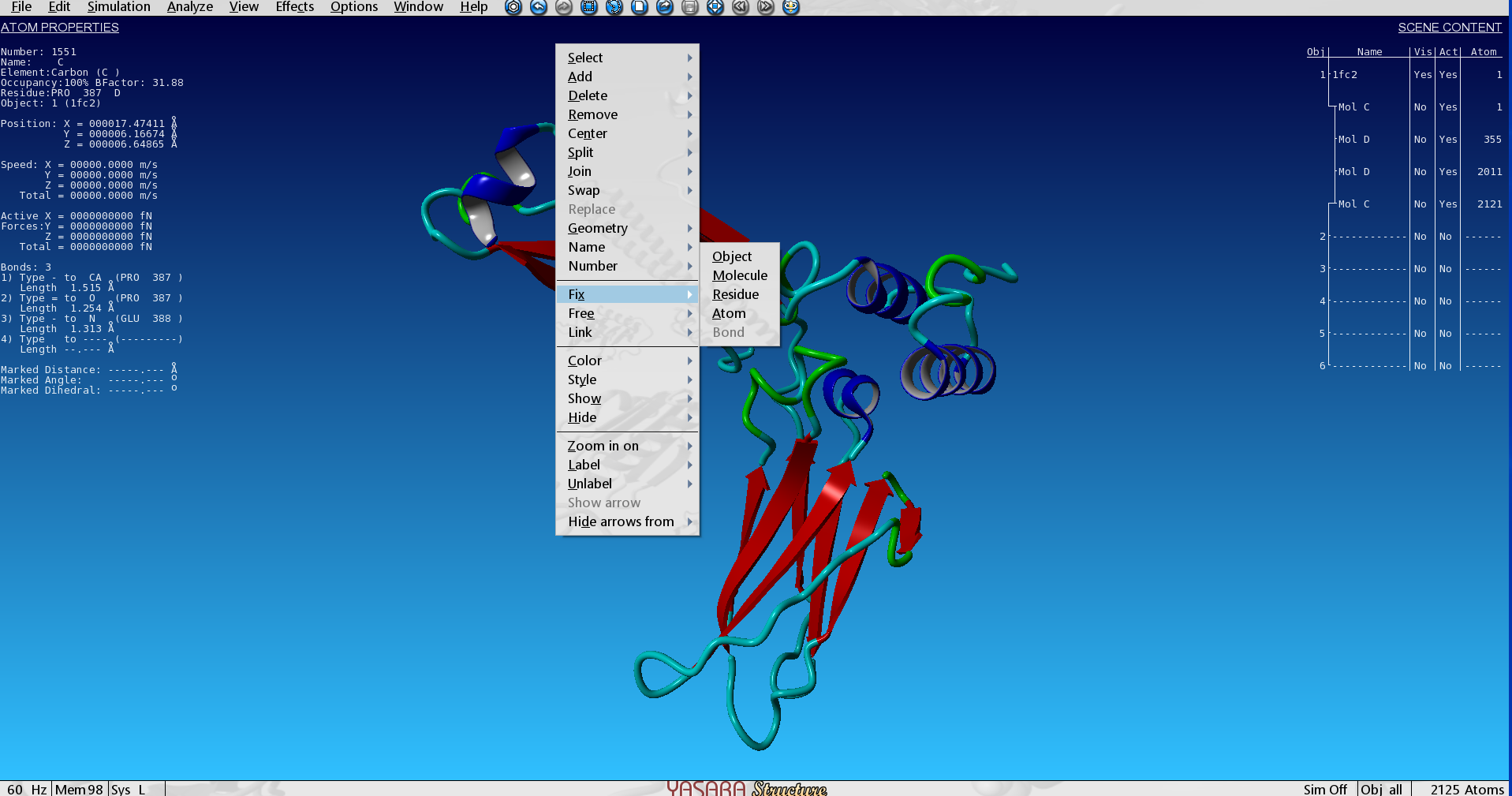The YASARA user interface
Open YASARA and you should see a screen that looks similar to 2.1.
When a file is loaded it will appear in the center of the display in one of the various visualiation styles to be covered in a section 4.2. So far we have not learned to load a molecule or to select anything, so do not panic! This chapter is one to read to start and then read again after you have read through Chapters 4 to 7.
The next sections will orient you to the Heads-up Display (2.1), the command line console 2.2, the top Menu 2.4, and the file organization (2.6), and includes a section on where to find help (2.5).
Heads Up Display (HUD)
The Heads-up Display or HUD in YASARAview consists of two main pieces: the Atom Properties list and the Scene Content 2.2.
Atom Properties
The Atom Properties list describes the characteristics of a selected atom. These characteristics include the identifying traits such as element, what residue:Mol:Object it is a part of, and where it is located. Further characteristics place it within the context of the molecule being displayed under the section Bonds. Finally, there is a section containing 3 items: Marked Distance, Marked Angle, and Marked Dihedral. These are types of measurements we will use in Chapter 6.2.
Scene Content
The Scene Content table shows what models are loaded into the system. There are 5 columns in this table: Obj, Name, Vis, Act, and Atom.
Obj: Numerical assignment of the Obj. This is a useful indentifier for commands to maniupulate the Obj.
Name: Indicates the name of the model. Typically this is the PDB ID, however you can rename the Object.
Vis: Stands for “Visible”. When a file is loaded, this will default “Yes”. Left-clicking with the mouse on “Yes”, will change it to “No” and the model will disappear.
Act: Stands for “Active”. When a file is loaded, this will default to “Yes”. A file that is active can be manipulated and is included in the view screen if Vis is set to “Yes. To change this to”No" the Object must be removed from the screen 3.7.
Atom: This column shows the number of the first atom in the Object. Like Obj this number can be useful for manipulating the view and other commands.
Hiding the HUD
The HUD can be hid or revealed by pressing the “Insert” key. This will be important when taking screenshots or making figures as covered in Chapter 3.6.
The Console
You can manipulate the view and perform analysis of the molecules in YASARA through two methods: the Console and the Menu system (2.4).
The console can be accessed by pressing the Space Bar. The console will appear at the bottom of the program window as shown in Figure 2.3. Pressing the Space Bar a second time will result in a larger console window. To hide the console, click your mouse in the program window somewhere outside of the console area.
Commands are typed directly into the console in the YASARA command system or Python. You can also copy and paste into the console using the Ctrl+C followed by Ctrl+V keys. Additionally you can copy console text by hightlighting and pressing Ctrl+C. The latter activity will be a useful tool when we get to the chapter on Making Movies (7).
Up Arrow!
If you want to repeat or edit a command that you have already executed, whether in the console or using the interactive GUI or the menus, pressing Space Bar followed by the Up Arrow copies the previous command and allows you to repeat or edit the command to tweak the outcome. In YASARAview this is limited to the previous ten commands so if you know you are going to use a complex command again, copy it out before it is lost!
Tangent on using the command line and the interactive menus
Users who are new to YASARA are often hesitant to use the console to perform tasks. For my students, they report this is due to inexperience with non-GUI interfaces and a fear of not knowing what to do. I get it. It took me nearly 3 years of using YASARA before I became comfortable opening the console regularly and even today, I still have issues to get the command line to work every time and to find the correct commands.
BUT
knowing how the program makes changes to the contents of the window is valuable for understanding what happened if it is not readily apparent and if you need help, having a sense of the command that is causing problems will make finding aid easier. As you become more experienced, you might begin to find command line is more versatile and even faster (assuming you type efficiently).
For beginners, start by using the menus and checking the console for the command. Then start using the console to refine choices after using the menus to make the command. Finally, as you feel confident do as much as you can using the console.
Given the importance of computers to many scientific careers, experience working with command line will only make you more marketable and flexible in many situations.
Sequence Bar
Hidden toward the bottom of the screen is the Sequence bar (2.4). Moving the cursor toward the bottom of the screen brings the bar up. You can click on the amino acids and scroll through the sequence of the model using this bar. This is an easy way to navigate through the model and find the specific part that you are interested. The bar can be pinned on the screen by clicking the blue button on the top left side.
Where to find help
HELP!!!!
This is probably the most requested piece of information. The reason for putting this underneath all the orientation is to make getting help easier. YASARA has a specific set of words and phrases. Knowing the “jargon” of YASARA makes limiting the amount of information during a help request easier.
SearchDoc
The SearchDoc function can be found two ways:
Help>Search User Manual
OR
Press the Space Bar to open the console and type SearchDoc followed by the inquiry word or command. See code chunk below for examples.
# Search for every help page containing the word color
>SearchDoc color
# Search for every help page referencing the word PDB
>SearchDoc PDB
The help page will open as a webpage in your default web browser (2.8). This page will list every time that word or phrase appears in the YASARA documentation.
Clicking on any of the blue links will take you to the page for the command as shown in 2.9. These pages have 3 parts:
The box showing information on the command
A brief text description of the command and purpose
Examples of how to use the command in the console or in a macro.
Like this reference, the Menu row in the box describes where in the Menus this command is found. This is most useful early on and as you learn more about YASARA, the examples become useful too. Often you can compare what happened in your console to the examples to make sure that you are looking at the right command and using the correct arguments.
Help Movies
While not formally part of the help system, users can click on the Help category in the top menu and then choose Play Help Movie (Help>Play Help Movie) to access YASARA rendered movies introducing users to a variety of topics. The movies are interactive and useful for first-time users, however they are not searchable and can take a while to find a specific topic. Therefore, I recommend going through the help movies once or twice early on, but using SearchDoc as you become more experienced.
File system
Upon installing windows, YASARA creates a series of folders similar to that shown in 2.10. The number and types of folders will depend on your YASARA version, however there will be several constant folders. Unless you have another data management system, I recommend using the YASARA system to start out. When you save a file, it will go into a folder corresponding to that file type, which can save a number of beginner headaches.
Naming files and Data Management
While not specific to YASARA, having a good system to name and keep track of files that you create can save you many future issues. File names should be readable not only by a human but also the computer, especially if you are making a movie or executing a macro which iterates over a series of files. Therefore, some useful hints:
Use a single string when naming a file – 01_model_ubiquitin.pdb or 01_ModelUbiquitin.pdb not this is a file with ubiquitin.pdb You can read spaces, but they can do funny things in a program.
Avoid punctuation in file names – the only punctuation should be between the name and the file type 01_model_ubiquitin.pdb not 1:model/ubiquitin{today}.pdb Exceptions to this rule can be underscores (_) or dashes (-).
Dates or numbers can help organize your progress – 01_model_ubiquitin.pdb or 2018-08-01_model_ubiquitin.pdb If you use numbers make sure you use two digits even for numbers less than 10. It helps keep files in order in the file viewer. Dates can be in any format but YYYY-MM-DD is most common internationally.
Keep a key or notebook – This is will help you remember what you did along the way, but also help others who may work with or after you on the project. If you are using Open Science Framework (OSF) or Github to help with your project management, then the Wiki in OSF or the Readme in GitHub are great places to provide some insight into what your files are.
Never be afraid to start over – Sometimes you will dig a hole in your work and not be able to get out. It is okay to start over and try again. Data management takes a while to become routine, but should be a skill that you exercise often.
In-depth details on file naming and data management can be found in 9
Knowledge Self-Checks
Answers to questions are found in the Answers chapter under the Chapter Three header (8.1)
What action brings up the console in the YASARA window?
What console command allows you to swap a residue?
Where would you find the distance between to atoms?
How can you bring up the previous command in the console?
What is potentially problematic about each of the following file names?
ubiquitin.pdb
first model of a protein!.pdb
1_model_ubiquitin.pdb


